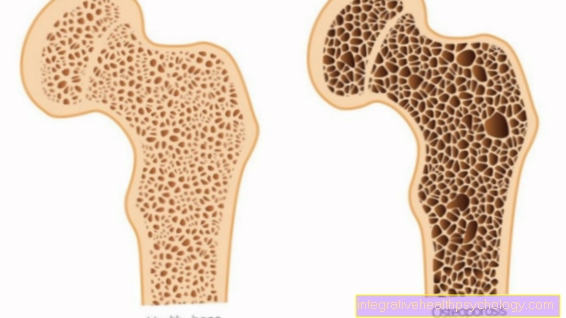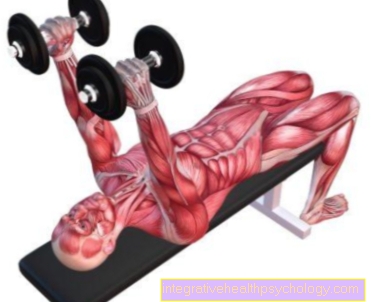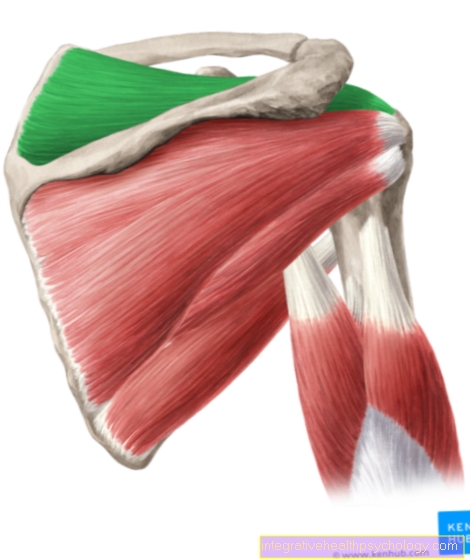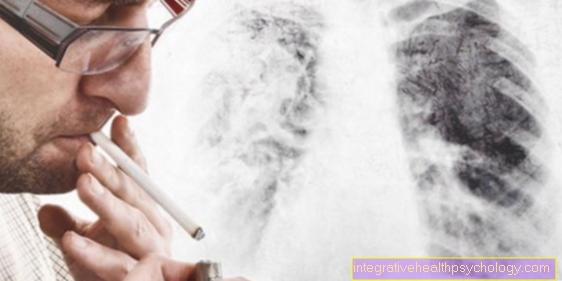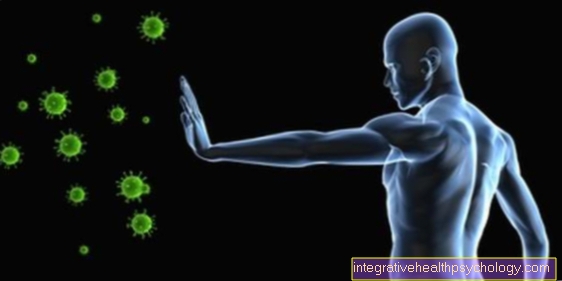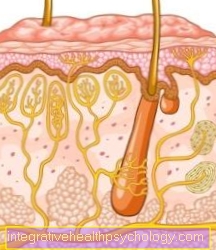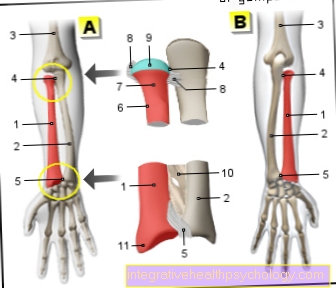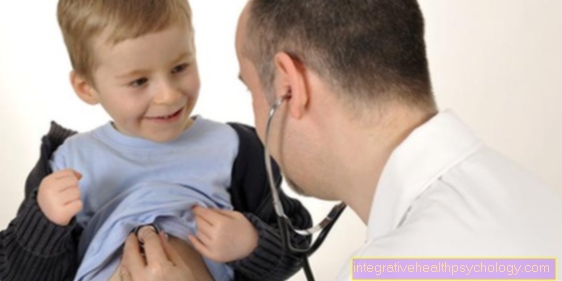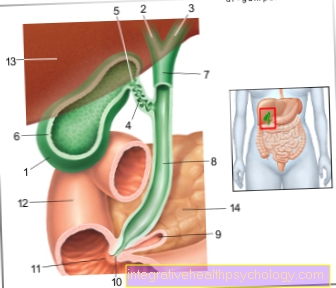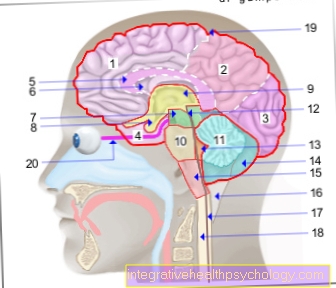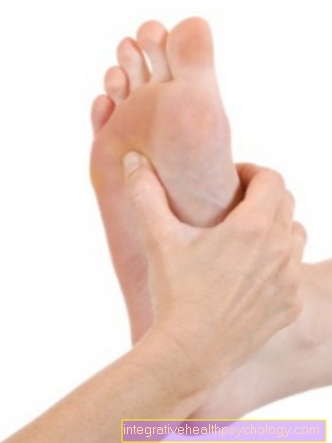Pain on inhalation right
What is pain when inhaling on the right side?
Pain when inhaling on the right side denotes breathing-dependent discomfort. It is characteristic that the pain is not noticeable when you exhale, but occurs suddenly when you inhale. They usually get stronger as the volume of the chest increases, i.e. towards the end of the inhalation.
The pain can have different pain qualities depending on the cause. The pain can feel stabbing, pulling, pressing, burning, etc. In order to find out possible causes of the pain when inhaling, it is also important to differentiate between pain in the entire chest or just on the right side. This may indicate the involvement of certain organs on the right side of the body.
Read more on the subject at: Pain on inhalation

Possible causes of pain on inhalation right
The causes of pain when inhaling right are very diverse. They often originate in the lungs, which can be respiratory infections, inflammation of the lungs or the lung membrane. Chest discomfort can also cause pain when inhaling. The ribs or pleura can be affected, and the intercostal muscles (muscles between the ribs) can cause pain when inhaling if there is inflammation.
Tension in the back can also be felt as breath-dependent pain. Less often, nerves emerging from the spinal cord and supplying the muscles of the ribs are responsible for the painful inhalation. Organs that typically cause pain on the right when inhaling include the liver and gallbladder. More rarely, the heart can be the source of the complaints, but most heart diseases are more noticeable in the form of left-sided pain.
Read more at: Causes of pain
Inflammation of the gallbladder
The gallbladder is an organ that sits just below the liver. It is therefore located in the right upper abdomen. Typically, the gallbladder itself causes discomfort when the biliary tract or the gallbladder itself becomes inflamed. Common reasons for this are small stones that become lodged in the gallbladder or biliary tract. This causes the bile to build up and can lead to inflammation of the gallbladder.
The pain associated with gallbladder inflammation often radiates from the upper right abdomen to the shoulder. They usually occur after particularly high-fat meals. The pain itself can be triggered by inhaling. When you breathe in, the chest enlarges, the liver is pushed down by the lungs, which can also create more pressure on the gallbladder, which can trigger the pain of a gallbladder inflammation.
Read more on the topic: Inflammation of the gallbladder
Pulmonary embolism
Pulmonary embolism is a condition in which a blood clot becomes lodged in an artery of the lung. This means that blood can no longer flow through the affected vessel. Depending on how big the affected vessel is, the symptoms can be more or less severe. Typically, there is difficulty breathing and chest pain.
If pulmonary vessels in the right lung are affected, the pain is particularly noticeable on the right side of the chest. In the worst case, when a very large pulmonary vessel is affected, the blood backs up into the right half of the heart, the heart cannot pump against the high pressure and life-threatening cardiac arrest occurs.
Find out more about the topic: How can you recognize a pulmonary embolism?
pleurisy
Inflammation of the pleurisy (pleurisy) is triggered in most cases by infectious pathogens such as bacteria and viruses; more rarely, autoimmune processes or drugs can also cause pleurisy. The pleurisy is often found in both halves of the chest, but if the inflammation is only concentrated on the right side, the symptoms can also occur in isolation on the right side.
Due to the inflammation of the pleura, it is particularly sensitive to movement. Especially when you breathe in, the chest expands and this also causes the pleura to stretch, which is noticeable through severe pain when you breathe in. In addition, the pain can also be more pronounced when coughing, and it usually improves when you breathe out.
For more information, see: pleurisy
hepatitis
Hepatitis describes various inflammatory diseases of the liver. In most cases, the hepatitis is caused by viruses (hepatitis A virus to hepatitis E virus). In addition to the typical pain in the liver (right upper abdomen), fatigue and loss of appetite can also occur.
Since the liver moves a little in the abdomen with every breath, the pain in the right upper abdomen can be breath-dependent. They then usually occur more intensely when you inhale. More rarely, autoimmune processes can also lead to hepatitis. Other causes of liver inflammation can be, for example, liver-damaging drugs.
Read more on the subject at: hepatitis
Problems with the shoulder blade
The shoulder blade rests directly on the back of the chest and can slide over the chest when moving. If there are problems with the shoulder blade, for example movement of the shoulder blade can lead to pain. Since the shoulder blade and the rib cage are very close, lifting the rib cage when inhaling can already cause pain in the affected shoulder blade.
In most cases, muscle discomfort is the cause of shoulder blade problems. This usually involves tension or injuries to the shoulder muscles, which also attach to the shoulder blade. Less often, injuries or pinching of nerves can cause problems with the shoulder blade. When it comes to discomfort to the shoulder blade on the right side, pain typically occurs in the right back, shoulder blade or shoulder itself when inhaling.
Cardiac arrhythmias
Cardiac arrhythmias represent a very complex clinical picture. In summary, changes in the conduction system of the heart usually lead to disorders of the cardiac rhythm, with the heart beating too slowly, too quickly or irregularly. With cardiac arrhythmias, pain usually occurs when the heart muscles cannot be adequately supplied with oxygen due to the malfunction.
Typically, there is sharp pain in the chest and pressure on the chest. Because the heart is on the left side of the chest, the left side is more likely to be affected by symptoms. However, atypical symptoms occur especially in women, so that the pain is also noticeable on the right side or, for example, in the epigastric region. The main reason that the pain occurs when you breathe in may be that when you breathe in, the pressure in the chest increases and thus the pressure on the heart.
Also read the article on the topic: Recognize arrhythmias
Thus, pain on inhalation is diagnosed on the right
Since pain when inhaling on the right is initially a very unspecific symptom, the diagnosis of the symptoms must be started very generally. The anamnesis, in which the origin of the symptoms and typical risk factors can be inquired about, is usually indicative.
A targeted physical examination of the lungs, chest, heart, liver and gallbladder and, if necessary, the back and shoulder can then be carried out. Depending on the suspicion, laboratory tests should then be carried out for the affected organ. Imaging methods such as ultrasound (especially suitable for the heart and liver) and X-rays (for the shoulder, lungs and chest) can also provide further information. If necessary, further special examinations are carried out depending on the suspected diagnosis.
Possible accompanying symptoms
The symptoms accompanying pain when inhaling are highly dependent on the cause of the discomfort. If a gallbladder or liver disease is the cause of the pain on inhalation right, then other liver disease symptoms tend to appear. These include, for example, so-called pruritus (itching) and jaundice (yellowing of the skin).
In the case of diseases of the lungs such as respiratory infections or pneumonia, flu-like symptoms are typical. There is a cough, runny nose, fever, fatigue, possibly also tiredness, fatigue and aching limbs. Other lung diseases and diseases of the chest (for example pulmonary embolism or pleurisy) often lead to shortness of breath and other breathing problems in addition to breathing-dependent pain.
If there are complaints to the muscles, nerves or joints of the upper body, the pain can also occur when moving. This is especially the case if, for example, the right shoulder or the spine is the starting point of the pain.
With causes such as cardiac arrhythmias or other heart diseases, symptoms such as decreased performance, reduced physical performance, occasionally pressure on the chest or a stinging in the chest are additional symptoms.
Back pain
In most cases, back pain occurs due to muscular imbalances. Often there is tension in the muscles. These can also be transferred to the mobility of the chest. When you breathe in, the chest moves, which is why back pain can occur depending on the breath. Occasionally, the back pain irritates nerve fibers emerging from the spinal cord. If nerve fibers that are related to the chest are affected, nerve pain can also be triggered by the movement of the chest when breathing in.
Also read the article: Pain in the back when breathing.
Therapy of pain when inhaling right
The therapy for painful inhalation is highly dependent on the cause. Symptomatic therapy of the symptoms with painkillers is often sufficient. Preparations such as ibuprofen, novalgin or paracetamol are typically used for this. If the pain when inhaling is so severe that natural breathing is impeded, stronger painkillers can be used temporarily. In addition, a detailed therapy of the cause is often useful.
In the case of heart, liver and gallbladder diseases, specific therapy should be given to the affected organ. Muscular complaints in the area of the back, chest and shoulder can often be treated with physiotherapy. In the case of infectious causes, antibiotics can be used, provided that the cause of the disease is bacteria. On the other hand, antibiotics are not effective in a viral infection. In addition, depending on the disease, the symptoms accompanying the cause should also be treated symptomatically.
Duration and prognosis of pain on inhalation right
The duration of the pain when inhaling right depends on the cause of the pain. If you have muscular problems in your upper body, the symptoms usually subside within a few days. If irritated nerve fibers are the cause of the discomfort, recovery may take longer. Heart and liver diseases are often chronic diseases that last a lifetime.
Depending on the severity of the disease, life expectancy can also be limited. One of the most dangerous causes of right inhalation pain can be a pronounced pulmonary embolism. If this is not discovered in time, there will be significant shortness of breath and severe cardiac dysfunction, which can lead to life-threatening complications.
Disease progression of pain on inhalation on the right
The disease progression of the pain when inhaling on the right is usually unspectacular. The symptoms typically worsen within the first few days. When the acute illness that is causing the symptoms subsides, the pain will improve again after a few days. If, on the other hand, a chronic illness is the cause of the pain, the symptoms begin gradually. Without adequate therapy for the underlying disease, the pain on inhalation worsens.
Pain on inhalation in the right side under the ribs
If pain on inhalation is localized on the right side under the ribs, then one should think of diseases of organs in the abdomen. In the right upper abdomen is the liver, which is normally completely hidden behind the costal arch. With liver disease, the organ can be greatly enlarged and cause pain under the ribs.
The liver is pushed down when inhaled and can cause breathing-dependent pain. Gallbladder problems can also be another cause. A very harmless cause of pain when inhaling on the right side under the costal arch can be a stitch that occurs during physical activity. In rare cases, other organs under the ribs are also responsible for the painful inhalation.Parts of the intestine can also trigger the symptoms.
Read more on the topic: Pain under the ribs when breathing


